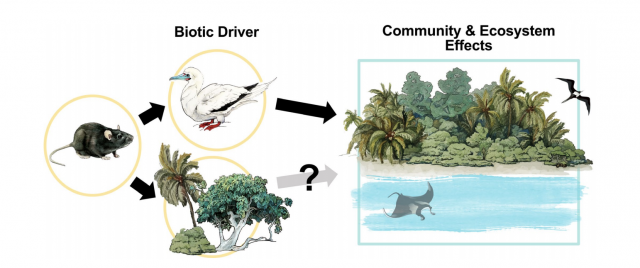
Abstract
"Invasive rodent eradications are frequently undertaken to curb island biodiversity loss. However, the breadth of rodents’ ecological impact, even after eradication, is not always fully recognized. For example, the most widespread invasive rodent, the black rat (Rattus rattus), while omnivorous, eats predominantly seeds and fruit. Yet, the effects of seed predation release after eradication on plant communities and ecological functions are not well understood, posing a gap for island restoration. We examined the role of seed predation release following black rat eradication in changes to tree composition and aboveground biomass across an islet network (Palmyra Atoll) in the Central Pacific. We conducted repeated surveys of seed, juvenile, and adult tree biomass and survival in permanent vegetation plots before and after the eradication of rats. We observed a 95% reduction in seed predation for an introduced, previously cultivated tree population (Cocos nucifera). Juvenile tree biomass of all species increased 14-fold, with C. nucifera increasing the most, suggesting that eradication increased this tree's competitive advantage. Indeed, based on stage-structured demographic models, rat eradication led to a 10% increase in C. nucifera population growth rate. The effect of invasive rodent seed predation varies considerably among the plant species in a community and can shift competitive dynamics, sometimes in favor of invasive plants. These bottom-up effects should be considered in evaluating the costs and benefits of eradication. Documenting the variation in invasive rodent diet items, along with long-term surveys, can help prioritize island eradications where restoration is most likely to be successful."
Citation
A Miller-ter Kuile, D Orr, A Bui, R. Dirzo, M Klope, D McCauley, C Motta, HS Young.(2020) Impacts of rodent eradication on seed predation and plant community biomass on a tropical atoll. Biotropica DOI: 10.1111/btp.12864